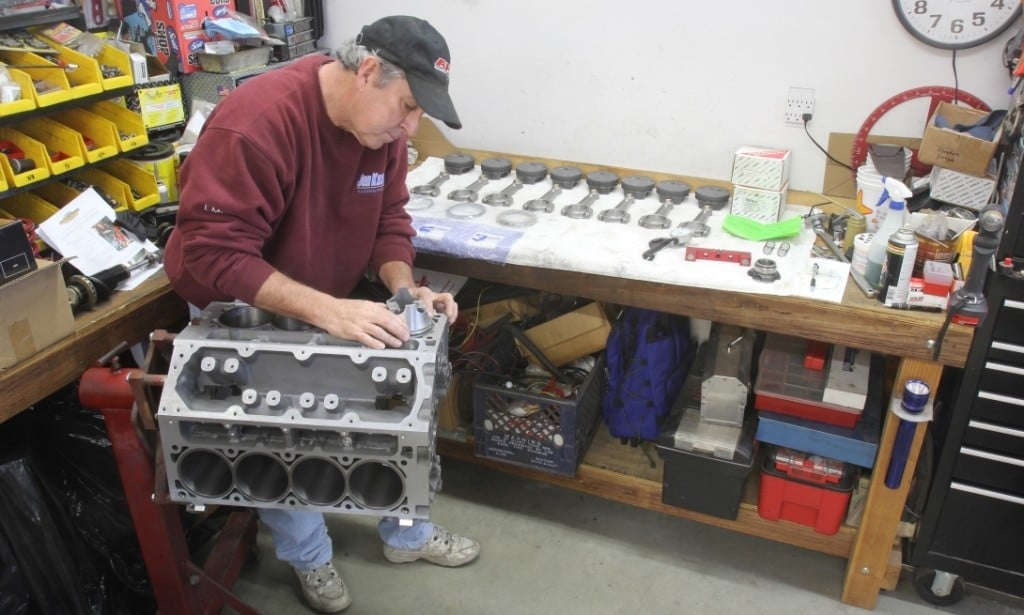There’s no question that the GM LS engine has come of age. If you’re looking for more horsepower from a mild street combination, the LS has that covered. If you’re new to this family of small-blocks, there are a few things you need to know to assemble an LS engine correctly. If you have previous engine experience, some of these suggestions will be familiar but there are still plenty of tips here that will help you assemble one of these engines quickly and easily.
The good news about building an LS engine is that in many ways this latest generation small-block is much easier to assemble than its predecessor. Gone are the hassles with carefully gluing four-piece pan gaskets together with copious amounts of RTV while praying it doesn’t leak. One of the more common concerns when assembling an LS engine is ensuring the front and rear covers are level with the pan. Once that is accomplished, spot the four corners with a touch of RTV, torque the bolts and that little issue is handled. Yes, all the fasteners are metric, but by now that should not be news.
We’ll start with the short block assembly and also list the important torque specs so you don’t have to go searching when it comes time to bolt that engine together. So without further drama, let’s get to it.
Shortblock Assembly Tips
- There are several stock ring thickness combinations for the various LS engines –double-check before buying a replacement set of rings.
- You can drill and tap the fitting above the oil filter as a convenient oil pressure source. If you buy a Holley oil pan, this fitting comes already drilled and tapped.
- The LS uses the same rod bearings as a small-block Chevy – making the bearing selection broad and affordable with + and – 0.001-inch sizes.
- LS main cap and connecting rod bolts are not torque-to-yield (TTY) but do use the torque angle (TA) specification. The spec is similar to TTY but the bolts are reusable. A wise alternative for high output engines is a set of ARP rod bolts and main studs that use traditional torque specs.
- Be aware that aftermarket cranks use SAE crank bolt threads instead of metric.
- You can use an old piston with a ring in the second groove as a cheap ring squaring tool for setting and measuring ring end gaps.
Cylinder Heads, Cam, and Valvetrain
- You can use a big-block Chevy cylinder head dowel if stock LS pieces are not available. The BBC dowel is roughly 0.635 and the LS dowel is 0.650 but you can expand the BBC dowel slightly and it works. The LS dowel is slightly longer.
- You can use a 24-inch long, 3/8-inch long dowel rod as a cam installation tool – the LS cam is hollow.
- A great upgrade for early LS engines is the LS3 center cover (PN 12598832). It uses an improved oil separator to reduce the amount of oil ingested through the PCV system.
- If you are upgrading the valve springs, it’s a smart move to also strengthen the pushrods. Typically, 080-inch wall thickness pushrods are a wise choice.
- COMP sells a slick tool (PN 5462) that makes changing two valvesprings on the head at the same time really easy.
Torque Chart
| Description | Torque | ||||
| Main Cap Bolts | Inner | Outer | Side | ||
| First Pass | 15 lb-ft | 15 lb-ft | 18 lb-ft | ||
| Second Pass | 80 Degrees, 51 Degrees | ||||
| Connecting Rod | (1st Design) | First Pass | 15 lb-ft | ||
| (1st Design) | Second Pass | 60 Degrees | |||
| (2nd Design) | First Pass | 15 lb-ft | |||
| (2nd Design) | Second Pass | 75 Degrees | |||
| Cylinder Head (11mm) | First Pass | 15 lb-ft | |||
| Second Pass | 90 Degrees, (Medium Bolts 50 Degrees) | ||||
| Cylinder Head (8mm) | 22 lb-ft | ||||
| Crankshaft | First Pass | 240 lb-ft (Use Old Bolt Then Remove) | |||
| Second Pass | 37 lb-ft (With New Bolt) | ||||
| Third Pass | 140 Degrees | ||||
| Crankshaft Side Bolts | 18 lb-ft (In Sequence) | ||||
| Oil Pump Mount | 18 lb-ft | ||||
| Cam Retainer Plate | 18 lb-ft | ||||
| Camshaft Bolt | 3-Bolt LS1 | 26 lb-ft | |||
| 3-Bolt LS2 | 18 lb-ft | ||||
| 1-Bolt, First Pass | 55 lb-ft, Then 50 Degrees | ||||
| Rear Cover | 22 lb-ft | ||||
| Front Cover | 18 lb-ft | ||||
| Rocker Arm | 22 lb-ft | ||||
| Flywheel | First Pass | 15 lb-ft | |||
| Second Pass | 37 lb-ft | ||||
| Third Pass | 74 lb-ft | ||||
Sources
COMP Cams
compcams.com


















